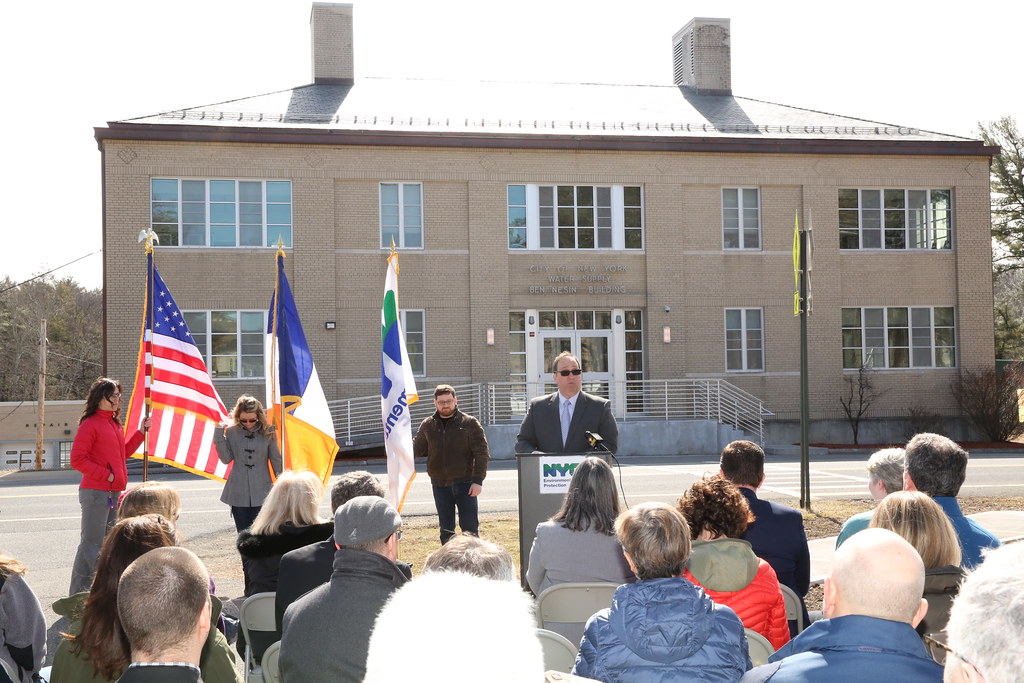Ben Nesin Building at Ashokan Reservoir Earns Leed Gold Award for Sustainable Design, Construction
August 12, 2020
The New York City Department of Environmental Protection (DEP) today announced that the Ben Nesin Building at Ashokan Reservoir has earned an award for incorporating sustainable design and construction practices in a $10 million renovation of the building.
The Ben Nesin Building earned the LEED Gold Award for its enviro-friendly rehab, which was completed in 2019. LEED—short for Leadership in Energy and Environmental Design—is an international certification system to recognize buildings that save energy and water, reduce greenhouse gas emissions, and use local or renewable materials in their construction.
“We are proud that DEP’s renovation of the Ben Nesin Building was recognized for meeting the highest standards of sustainability,” DEP Commissioner Vincent Sapienza said. “As we rehab our facilities and build new ones, DEP always aims to minimize our use of energy and water, cut our carbon footprint, and remain true to our core mission of protecting the environment.”
The Ben Nesin Building, located on Route 28A in the Town of Olive, houses about 35 employees who are responsible for the operation and maintenance of Ashokan Reservoir, Schoharie Reservoir and the lands that surround them. The four-story building was constructed in 1961 to serve as a water quality laboratory. It stopped being used as a laboratory when DEP finished its new Kingston Laboratory in 2008, but it continued to house engineers, watershed maintenance staff and other DEP employees. The renovation project began in late 2016 and was completed in 2019. The building is named for Benjamin C. Nesin, the noted scientist who served as New York City’s director of water quality laboratories from 1945 until his death in 1964.
The building’s renovation included a number of sustainable elements to earn the LEED Gold Award. The design utilized 100 percent of its existing structural elements, and 56 percent of its interior building materials, minimizing the amount of material that was disposed.
Water-efficient fixtures helped the building use 37 percent less water. The building also uses 40 percent less energy compared to its former baseline. Those savings came from the installation of high-efficiency heating, cooling and ventilation systems. Common areas inside the building, such as conference rooms, also use special monitors to adjust airflow based on the number of people in the room.
The Ben Nesin Building was also outfitted with energy-efficient LED lights. They were connected to a system that controls the lights based on whether people are in the room, and whether adequate daylight is coming through the windows. Parking areas were also set aside for bicycles and low-emission or no-emission vehicles.
DEP manages New York City’s water supply, providing more than 1 billion gallons of high-quality water each day to more than 9.6 million New Yorkers. This includes more than 70 upstate communities and institutions in Ulster, Orange, Putnam and Westchester counties who consume an average of 110 million total gallons of drinking water daily from New York City’s water supply system. This water comes from the Catskill, Delaware, and Croton watersheds that extend more than 125 miles from the City, and the system comprises 19 reservoirs, three controlled lakes, and numerous tunnels and aqueducts. DEP has nearly 6,000 employees, including almost 1,000 scientists, engineers, surveyors, watershed maintainers and other professionals in the watershed. In addition to its $70 million payroll and $168.9 million in annual taxes paid in upstate counties, DEP has invested more than $1.7 billion in watershed protection programs—including partnership organizations such as the Catskill Watershed Corporation and the Watershed Agricultural Council—that support sustainable farming practices, environmentally sensitive economic development, and local economic opportunity. In addition, DEP has a robust capital program with $20.1 billion in investments planned over the next decade that will create up to 3,000 construction-related jobs per year. For more information, visit nyc.gov/dep, like us on Facebook, or follow us on Twitter.





